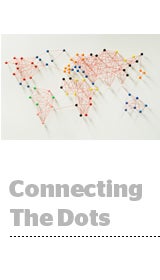 Data collection can pose a challenge beyond borders.
Data collection can pose a challenge beyond borders.
Looking for IT professionals who work at companies with more than $20 million in revenue and headcounts over 250? Fashionistas between the ages of 18 and 34 with an affinity for shoes?
Most data providers could take care of that type of request before breakfast in the US, where the majority of available data on file is compliant, detailed and current. But if a brand’s looking for international reach and scope, the assignment is a bit trickier, said former Cravebox chief Kitty Kolding, now CEO and president of data acquisition company Infocore.
Infocore uses a predictive scoring system to assist brands like Honda, Toyota, IBM, Disney, American Express and Procter & Gamble assess which global data sources will perform best for campaigns in advance of live testing.
Infocore also works with data providers like Epsilon and Experian to help them expand their global footprint.
“Once you get out of the US and Western Europe, it can be somewhat of an adventure to find accurate, legal data that you can use for a client’s specific purposes,” Kolding said.
And those purposes can get quite specific. Over the years, Infocore has received some pretty wacky data requests, including tea buyers residing in Singapore, deceased consumers in Mexico and Canada, middle-class women age 50-plus who are either about to reach or have already entered menopause located in India, China or Russia and are also affluent enough to pay for health insurance and consumers in major EU cities between age 30 and 45 who have at least one child, one pet, one smartphone, an elderly relative living with them – and who have been the victim of a crime within the past 12 months.
But offbeat demands aside, pulling together even the more mundane data requests to reach consumers outside of the US often comes attendant with some fairly sizable hurdles.
“It’s not only a challenge to find good data, you also need to make sure that it’s compliant with quickly changing legislation and the particular do’s and don’ts in each country,” Kolding said.
Take China. As mediaQuark CEO Tom Simpson noted in a previous chat with AdExchanger, “Data can be quite hard to come by in China, with publishers and advertisers slow to move into this space due to privacy concerns. Although many clients do fantastic work with data in silos, this hasn’t necessarily translated to the industry as large, [but] it is a significant opportunity for the next few years.”
It’s an opportunity Infocore is looking to capitalize on by cultivating relationships with data providers on the international scene.
Infocore tracks roughly 12.3 billion records in 85 countries, 80% of which are consumer, 20% of which are B2B. But rather than processing the data itself, Infocore logs information about the data sources, including how many records are available for purchase, how those records are priced and if it’s compliant, aka whether the opt-in process was carried out in a kosher fashion.
In a recent project for the China arm of a large multinational CPG company, for example, Infocore was tasked with taking the company’s client file, which comprised only the full name and address, and beefing it up with verifiable demographics. But because international data sources can be spotty, Infocore had to pull gender from one file, the presence of children in the home from another, income level from a third and so on, all while making sure that each new data nugget was obtained in a fully permissioned way.
 Brands also have to play by the local cultural rules. In some countries, for example, it’s either forbidden or culturally not acceptable to store revenue numbers on privately held companies, while in Hong Kong there are three different do-not-call lists, which means providers need to scrub any telemarketing files against all three regional DNC registries before use.
Brands also have to play by the local cultural rules. In some countries, for example, it’s either forbidden or culturally not acceptable to store revenue numbers on privately held companies, while in Hong Kong there are three different do-not-call lists, which means providers need to scrub any telemarketing files against all three regional DNC registries before use.
“It all functions a little differently depending on where you are,” Kolding said.
But in the US, where brands are spoiled for data riches, there are other challenges to overcome. With so many data sources to choose from, it becomes a matter of identifying which one has the best records to match a particular request. According to Kolding, there are around 50,000 unique sources of data available in the US to reach consumers and business individuals – roughly 200 times more than anywhere else in the world.
In some cases, it’s just a matter of opening a brand’s eyes to the possibilities. One Infocore client, for example, a large retailer, was looking to reach new movers. In negotiations with Infocore, a rep from the retailer made a comment along the lines of, “We’re already using all of the new mover sources out there.”
“So we said, ‘You’re using 275 sources?’ and they paused and said, ‘No … there are only three or four, right?’” Kolding said. “But there are hundreds of sources out there for every type of individual. When we showed this retailer how many potential sources there were just for new movers in the US to choose from, they were blown away.”














